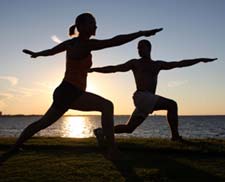Back Pain and Exercise
Posted by: Diagnosis.com
Category: Back Pain
 Many back-pain sufferers stop exercising for fear of aggravating their pain. But avoiding exercise is one of the worst things you can do for your back, according to a consensus of experts assembled by the federal Agency for Health Care Policy (AHCPR) and Research. The Agency’s national treatment guidelines call for as much exercise as your back can comfortably handle starting within two weeks of the injury. The AHCPR recomended: walking, swimming, and cycling.
Many back-pain sufferers stop exercising for fear of aggravating their pain. But avoiding exercise is one of the worst things you can do for your back, according to a consensus of experts assembled by the federal Agency for Health Care Policy (AHCPR) and Research. The Agency’s national treatment guidelines call for as much exercise as your back can comfortably handle starting within two weeks of the injury. The AHCPR recomended: walking, swimming, and cycling.
In the years since the AHCPR guidelines were released, most back pain experts have begun encouraging exercise even sooner, within two or three days, as long as it doesn’t aggravate your pain, explains sports medicine specialist Brian Shiple, D.O., an assistant clinical professor of family medicine at Allegheny University of the Health Sciences in Philadelphia. After ruling out other possible problems (see “And Finally… ” below), Dr. Shiple prescribes “lumbar stabilization” stretches (see sidebar), and walking, swiming, or cycling, with a goal of exercising regularly for about a half-hour three to five times a week.
“Just make sure your exercise program is moderate,” Vollowitz says, “and doesn’t re-injure your back. Be careful. Anything that pounds, jars, or suddenly twists your back is out, so forget high-impact aerobics, racquet sports, and most team ball games.”
Exercise also helps prevent back pain. That’s what California researchers found in a widely noted study of Los Angeles firefighters. Those who were the least fit had the most complaints about back pain. Fitness was significantly protective.
Yoga for Back Pain
Nashville pathologist Mary Pullig Schatz, M.D., had tried everything for her chronic low-back pain, but nothing helped. She was just about to have surgery when she tried yoga. It seemed to help. She kept it up. The more yoga classes she took, the better she felt. In addition to her medical practice, Dr. Schatz became an Iyengar yoga teacher and wrote the noted yoga-based guide to back self-care, Back Care Basics. “Yoga cured my bad back. It’s gentle exercise that builds strength nd promotes flexibility.”
Dr. Schatz is not the only one. In England, a survey of 3,000 yoga students showed that among those with back pain, yoga helped 98 percent. On this side of the Atlantic, a survey of 500 back pain sufferers by former New York Times science writer Dava Sobel showed that yoga was among the most effective therapies. Neither of these surveys was rigorously scientific. But even so, it’s clear that yoga helps many people with bad backs.
Yoga classes are available throughout the U.S. and Canada. Among the various schools, Iynegar yoga is the best choice if you have back pain because certified Iyengar instructors are trained to adapt the postures to provide maximum benefit and minimum harm to people with low-back problems. Be sure you mention your back problem to any instructor before the class begins. And if any stretch or posture causes any pain, stop doing it.
Tai Chi for Back Pain
Like yoga, tai chi routines involve gentle stretches. Dr. Subotnick calls tai chi “very helpful” for back pain. At the University of North Carolina, reserchers survyed 216 tai chi instructors, asking which medical conditions they thought it helped. Back pain came in at the top of the list. In one study, 51 people with chronic low back pain were either advised to lives their lives as usual, or enrolled in a tai chi class (weekly, 90 minutes), and asked to practice on their own daily (15 minutes). After six weeks, the tai chi group reported significantly less back pain, and less depression.
I had my back pain since 2years.I live in a small town. I can’t get any good suggestion from local doctors. I am working as a data entry operator. So, minimum 9-10 hours I engaged with my computer. What will I do ? and which extercises are better for me.
Thanking you
Manojit